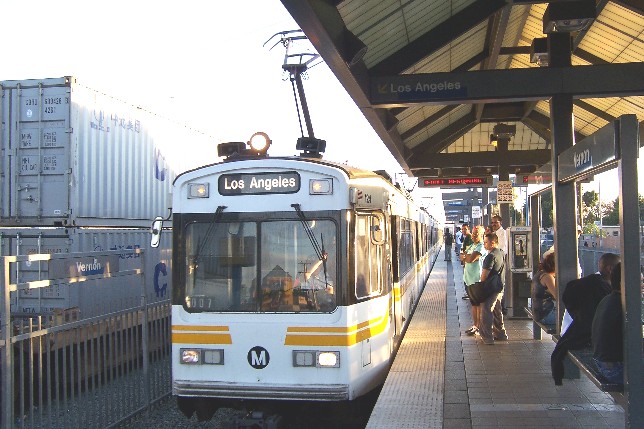 Los Angeles Blue Line train
Los Angeles Blue Line train(Photo: L. Henry)
Light Rail Progress can be contacted at: Light Rail Progress |
Certainly, one of the primary issues at the core of the "Transit Wars" – the incessant attacks on rail transit by pro-automobile critics and the responses by rail supporters – is the implications for urban travel and traffic congestion. Within a context of overwhelming government-driven emphasis on highways, ongoing expansion of streets, highways, and other motor vehicle facilities on a vast scale, overwhelming public dependency on motor vehicle transport, and the resultant precipitous growth in vehicle ownership and use in urban areas, any congestion-mitigating effects of a single new transit route, such as a rail line, are extremely hard to assess. However, evidence – often provided by special circumstances – does emerge from time to time to demonstrate that public transit does play a significant role in alleviating traffic congestion compared to the level of congestion that would otherwise be experienced without it. The latest such study to provide additional evidence of the congestion-reduction benefits of public transit, particularly urban rail, analyzes data from the 2003 Los Angeles transit strike. Study results are presented in a paper, "Effects of the Los Angeles Transit Strike on Highway Congestion" by Shih-Che Lo and Randolph W. Hall, published in Transportation Research, Part A, Vol. 40, No. 10, pp. 903-917. The article summarizes the researchers' analysis of highway sensor data to evaluate traffic flow and congestion delays during and after the 35-day transit strike. According to the analysis, the data indicate that traffic speeds declined as much as 20% during the strike, and rush hour duration at specific locations increased as much as 200%, despite the fact that transit users represent a relatively small portion of total travelers and the increase in total vehicular traffic was small. Speed reductions were particularly severe along rail transit corridors. Traffic speeds declined, most sharply upstream from locations where queues normally end. An abstract of the Lo & Hall study (and information for ordering the full study) can be found at this link: Effects of the Los Angeles transit strike on highway congestion.
Ed Tennyson, PE, a technical consultant to the Light Rail Now Project, hails the Los Angeles transit strike study as a valuable contribution to public transit and professional understanding of the impact of transit on traffic congestion.
The highway-oriented Texas Transportation institute, notes Ed, each year says the National Capital is saving a billion dollars a year by having MetroRail to avold more traffic delay. San Francisco: 1997 transit strike
So what do these incidents prove? Ed Tennyson sums it up: "Transit matters, very much." NOTE: information on the study of the Los Angeles transit strike of 2003 by Shih-Che Lo and Randolph W. Hall was originally brought to our attention by Todd Litman of the Victoria Transportation Policy institute. Light Rail Now! websiteURL: http://www.lightrailnow.org/news/n_lrt_2006-11a.htm Updated 2006/11/05 |
|
|
|
||